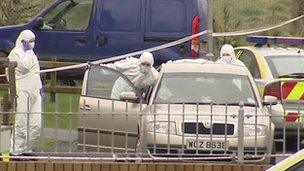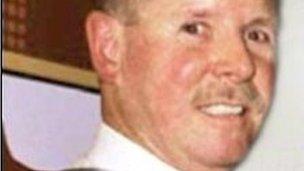The story of the Stephen Carroll murder trial
- Published

Constable Carroll was murdered after answering a 999 call
Constable Stephen Carroll, 48, was the first police officer to be killed in Northern Ireland since the formation of the PSNI.
He was shot dead after terrorists lured police to a call-out in Lismore Manor in Craigavon on the night of the 9 March 2009.
At the time the dissident republican group, the Continuity IRA, claimed they were responsible for the shooting.
Constable Carroll who was originally from the Republic of Ireland, but who had moved to England as a child, was a married man with a son and grandchildren who lived in the Banbridge area of County Down.
He had served in the police force for more than 24 years.
Former Sinn Fein councillor Brendan McConville, 40, of Glenholme Avenue, Craigavon, and John Paul Wootton, 20, of Collindale, Lurgan, were charged with his murder in May 2011.
They were also charged with possessing an AK47 assault rifle and ammunition allegedly used in the shooting at Lismore Manor.
John Paul Wootton also denied attempting to collect information on "a certain police constable" and his home address, likely to be of use to terrorists between January and March 2009.
The prosecution argued when the trial began in January that DNA and other evidence could link the two men to the Mr Carroll's murder.
They claimed Mr Wootton's car was parked close to the scene of the attack and drove off within minutes of the killing.
A prosecution barrister said that Mr McConville's DNA was found on a brown jacket removed from the boot of the car and he claimed gun residue was also discovered on the coat.
A scientist told the court that DNA on three separate sites on a brown jacket found in the boot of Mr Wootton's car had a one in a billion chance of belonging to anyone other than Mr McConville.
Despite Mr McConville's protestations that he did not own the jacket, Faye Southam said that in her opinion "the findings are more likely to be obtained if he was the regular wearer of the jacket".
Witness M
Her evidence was rejected by defence lawyers who argued that the coat which had Mr McConville's DNA on it, which was found in the alleged getaway car, could have been worn by up to five other people.
The prosecution's key evidence against Mr McConville came from a man known only as Witness M, who told the court that he had been out walking his dog on the night of the murder, and saw Mr McConville at the scene of shooting - ''the firing point'' - which was at waste ground to the back of the Lismore Manor Estate and around 50 metres from where Constable Carroll had parked his patrol car.
The prosecution said this was a clear case of recognition, that Witness M had known Mr McConville since he was young, recognised him, could describe what he was wearing and that they had even ''communicated with each other''.
The defence however described Witness M as a "Walter Mitty-type character who liked to tell tales''.
They say he lied to the court ''at least twice and maybe even three times'' about issues with his eyesight, and that he had changed his account of what he claims to have seen that night on four separate occasions.

Constable Stephen Carroll, 48, was the first police officer to be killed since the formation of the PSNI
The defence team had argued that the evidence was unfair to Mr McConville and should be thrown out, but the judge said, even if it was unfair, it was still admissible.
The prosecution alleged that the murder weapon, an AK-47 assault rifle from Eastern Europe, which was recovered by police from under an oil tank in a house in the Pinebank area of Craigavon, had been wrapped in the jacket when or shortly after it was fired.
They also alleged that gun residue was found on another coat discovered in a search of Mr McConville's house at Glenholm Avenue, Craigavon.
However, an explosives expert strongly criticised the prosecution team.
The forensic scientist, who was a defence witness, said he has been constantly frustrated and found it very difficult to do his job due to the "shifting sands of the prosecution".
He said they were inconsistent. The witness was especially critical of two forensic scientists who were prosecution witnesses and who had examined the murder weapon.
He said he was at a loss to understand why the gun had not been cleaned before it was test fired and that the lack of control in the experiments invalidated any results.
Residue
The scientist also told Belfast Crown Court that since 2006 the FBI has not used gunshot residue evidence in its cases due to the variability of results.
The court was also told that a special army intelligence unit had placed a GPS (global tracking system) into Mr Wootton's car at some point prior to the shooting.
This, the prosecution argued, tracked the whereabouts of Mr Wootton's car that night and showed the vehicle close to the scene at the time of the murder.
It also emerged that the tracking device was ''wiped'', and that data from the hours after the killing was lost.
Three soldiers gave evidence anonymously and failed to explain how the data was deleted from the device.
The court also heard that the army had been "very reluctant" to hand over the data from the device to the police, and that "negotiations involving the chief constable and maybe even above that level", had taken place.
Eventually the army gave the data to detectives, but only after the PSNI had threatened to seize it under warrant.
Defence lawyers argued the prosecution case was weak and inconclusive and called for the trial to be stopped due to a lack of evidence.
They argued said "a jury must convict on substance rather than suspicion", while the prosecution argued evidence was ''strong'' and that the accused had "planned and participated in the killing".
Defence QC Brendan Kelly for Mr McConville submitted that even if Witness M could put Mr McConville at the scene prior to the shooting, what evidence was there that he "was up to no good".
Mr Kelly described the identification evidence as poor, and argued that a jury properly directed could not convict, unless there was supporting evidence, which he claimed the prosecution failed to produce.
Arthur Harvey QC, for Mr Wootton in opening his final submissions claimed there was a breakdown, a distortion in the forensic evidence, over a coat found in his car and the legal proofs absolutely essential to link it with the shooting and Mr Wootton.
- Published1 March 2012
- Published29 February 2012
- Published28 February 2012
- Published17 February 2012
- Published13 February 2012
- Published8 February 2012
- Published30 January 2012
- Published12 January 2012
- Published17 May 2011